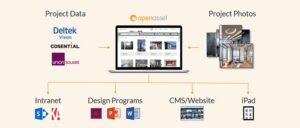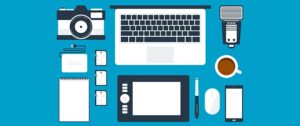What Does Implementation Look Like at OpenAsset?
Jun 29, 2023

Implementing a DAM system is not an easy task. At OpenAsset, we understand the hard work and significant investment that comes with onboarding a DAM solution for your AEC firm. Fortunately, our Onboarding Team and implementation process have successfully onboarded more than 800 clients, offering them support each step of the way.
In this blog, we’ll review what the implementation process looks like at OpenAsset and what you can expect during onboarding. By the end of this blog, you should have a clear understanding of what to expect when implementing OpenAsset.
OpenAsset Implementation: Onboarding Steps
Although every implementation process differs, four main onboarding steps are commonly followed by all clients who use OpenAsset:
- Education
- Migration
- Configuration
- Transition to Adoption
In each stage, there are customized milestone meetings planned to ensure a smooth onboarding process. Our primary objective is to ensure that all of these calls take place to guarantee a successful implementation.
“During the initial discovery phase, our team conducts a comprehensive discussion to gain a deeper understanding of every client’s unique challenges, goals, and requirements. This allows us to tailor our implementation plan to align with your specific needs and maximize the value your team will receive from our platform. We’ll also identify any potential areas for improvement and provide you with recommendations to ensure we’re setting your team up for success in the long run,”
-Christopher Ha, Implementation Manager at OpenAsset.
Implementation usually takes about 4–6 months from kick-off to rollout but the timeline may vary depending on the project’s scope and your available resources.
Step 1: Education Stage
First, we’ll focus on setting achievable goals and timelines for your firm’s onboarding as well as teaching you the basics of the system. We meet with you to provide comprehensive training on OpenAsset and its features, benefits, and common workflows.
We also discuss your workflows and your current project and digital asset storage methods. By the end of this stage, we collaboratively develop a migration plan to seamlessly transfer all of your content into OpenAsset.
What Does This Stage Include?
- Onboarding Kick-Off Call
- OpenAsset 101 Overview
- Template Overview
Timeline for the Education Stage
2–4 weeks
Step 2: Migration Stage
The migration stage is usually the most time-consuming phase. During this stage, your team will primarily work outside the OpenAsset system, focusing on preparing content for upload into OpenAsset. Most of our new clients take advantage of our Data Migration Service to move files, (images, videos, PDFs, and documents) from where they are currently stored (another DAM, local or network server, or shared drive) into OpenAsset. This service enables our new clients to benefit from a faster OpenAsset upload and it requires very little effort from the client’s side as the migration is managed by the OpenAsset Support team.
If you opt for our Data Migration Service, you will work with our Onboarding and Support Team to scope the data migration, review your goals for the project, and assess the current structure of your file storage. We’ll review the projects and content that were migrated into the system, action items, and file-level metadata. Because we have migrated hundreds of clients’ data into OpenAsset, you can trust that your content is in safe hands.
If there is anything additional you’d like to add to the system, we’ll also talk about how you can manually upload content on your own quickly and efficiently or work with us to do any type of import in bulk.
Once we have successfully migrated all your priority content into the platform, we will have the opportunity to discuss how you can maximize the value of your content. This will enable your team to establish a foundation for long-term success.
What Does This Stage Include?
- Planning & Strategy call where we will work with your Onboarding Champions to develop a game plan for migrating or manually uploading your content into OpenAsset
- Client preparing and/or organizing content into an appropriate format to be migrated
- Client delivering content to the OpenAsset Team
- OpenAsset Team initiating migration service
- Post-Migration review with your Implementation Manager after your content has been migrated into your OpenAsset system
Timeline for the Migration Stage
About 4–8 weeks
Step 3: Configuration Stage
During the configuration stage, we work with you to personalize and customize your OpenAsset system. We teach and assign action items to ensure that the system is configured according to specific requirements and is easily accessible to new users.
The configuration stage takes place once your content is successfully imported into the system, and we provide training on how to use it. Our priority during this stage is to help you feel confident while using the system. We will provide thorough guidance on common workflows to help your team succeed.
What Does This Stage Include?
- System configuration and knowledge check-in call
- Reviewing hero images and project locations
- Filling in any gaps in project keywords
- Finalizing taxonomies (project and file)
- Applying file keywords (and making a plan for the future)
- Reviewing access levels and marketing preference
- Custom image sizes
- InDesign plug-in (if applicable)
- User Management or Single-Sign-On
- Groups and permissions
Timeline for the Configuration Stage
About 2–3 Weeks
Step 4: Transition to Adoption
Once the configuration stage is complete, we’ll enter the final stage of the onboarding process. Your Implementation Manager will transition into a supporting role and introduce your firm to our Customer Success team. Following the collaboration with our Customer Success Team, we will review any pending tasks or issues that require a solution before transitioning to the ‘Adoption’ phase.
During the ‘Adoption’ phase, you will begin the process of rolling out the system to other users, enabling them to adopt and integrate OpenAsset into their daily work. At this stage, your system will be in a shareable state. While your team may continue to add file keywords or contribute new projects to the system, it will serve as a starting point for other members to start using the tool effectively.
Together, we will strategize and plan the training process, define the rollout strategy, and refine your workflows to align with your vision. This collaborative effort ensures that all necessary preparations are complete before launching the system.
“The question that drives just about everything I do in my role is: How can I help customers leverage OpenAsset to be better in their roles and hit their goals?”
– CJ Teeter, Customer Success team at OpenAsset
He goes on to say, “When we hear clients share with us how they were able to use OpenAsset to quickly find assets that demonstrate their experience and tell their story, or collaborate more effectively with their colleagues on a proposal – that’s the kind of feedback that inspires us to continue striving to help firms solve their business challenges.”
What Does This Stage Include?
- Adopting OpenAsset
- Introducing the client to the Customer Success Team for planning strategy
- Discussing workflows and adoption plan for OpenAsset
- Strategizing and planning for training new users
- The official rollout of OpenAsset
Timeline for Transition to Adoption Stage
About one week
Additional Onboarding Services
As part of the implementation process, we offer additional onboarding services to our clients. Whether you need custom integrations, connectors, or templates, we’ll work closely with you to make sure this process is a success.
Each implementation may have slightly different needs and depending on your team’s needs and resources, these action items may lengthen and/or shorten the onboarding process. However, we understand that each client may be starting from a different point in their OpenAsset journey, may store data differently, or have different levels of resources available to work on this project. Therefore, regardless of how you decide to approach your implementation, we will provide support every step of the way.
The additional services to consider are:
Employee Modules
- The goal of implementing the OpenAsset Employee Module is to create detailed employee profiles that include important professional and personal information, along with related files like employee headshots.
- Employees are tied directly to projects in your OpenAsset system, giving visibility into who has worked on what project.
- Most of our clients using the Employee Module leverage custom Resume/CV templates that can be generated directly from OpenAsset.
- The Employee Module has 4 major milestones: Employee Data, Employee Headshots, Project Association, and Templates.
- Employee Modules can be tackled after the post-migration for projects or can run simultaneously with project-related efforts.
Connectors
- Connectors: Templafy, Procore, Unanet CRM, Deltek Vision, Deltek Vantagepoint. Integrate OpenAsset into your other systems to streamline the flow of data and reduce time inputting information into multiple systems.
- OpenAsset Connectors are typically set up within the Migration phase or as soon as possible.
Custom Integrations
- OpenAsset users can utilize our REST API to build integrations with a wide range of systems that use modern programming languages.
- We offer REST API documentation and our support team will share best practices with your developers or IT team to ensure your integration projects are a success.
- Custom integrations are dependent on your team’s resources, timelines, and priorities.
Templates
- Custom Templates improve organizational efficiency and promote consistency in creating documents.
- You can export custom templates out of OpenAsset into various programs, including Adobe InDesign, Affinity Publisher, Microsoft PowerPoint, and Microsoft Word.
- Templates can be implemented once all relevant data has been imported or entered into OpenAsset (typically post-migration stage).
Launching OpenAsset
To demonstrate how we’ll support you every step of the way during the launch process, this is what the different phases look like:
Phase 1: Pre-Launch
In preparation for the launch of your OpenAsset system, we will organize a series of sessions to assist with training and preparation for your team. These sessions include four necessary discussions, and we will also conduct regular monthly check-ins as needed.
Phase 2: Launch
We will work together with you to establish appropriate timelines for your diverse user groups. OpenAsset can adapt to different roles during the training sessions, including full facilitation, a hybrid approach, or providing support as needed. The level of support required for the launch session(s) will be determined in advance during the planning and strategy call.
While we have a range of standard workflows that we cover for everyone, we are also capable of customizing them to meet your specific requirements or adopting a partner role where your internal teams take the lead. Regardless of the approach chosen, we aim to provide assistance and support throughout the process.
Phase 3: Post-Launch
After your launch session(s) with OpenAsset, our priority is to maintain regular monthly check-ins to keep your team on the right track. Furthermore, we highly encourage your team’s active participation in the following discussions with us:
- Post-Training Check-In
- Workflows With OpenAsset
- Key Stakeholders Regroup
- Executive Business Review
The Customer Success Team will be your strategic partner as you continue to use, adjust, and contribute to your OpenAsset system. Additionally, we host regular live training webinars designed to provide your users with the knowledge and tools to use OpenAsset.
Tips for a Successful Implementation
Understand What’s Included
Onboarding at OpenAsset includes two options:
- Premier
- Plus
Our “Premier” option is best for larger clients moving from another DAM or needing multiple file migrations. This option includes up to ten custom templates within the first year.
Our “Plus” option includes one data migration and up to five custom templates within the first year.
Prepare your files
Before implementing a DAM solution like OpenAsset, it’s helpful to get your files ready by taking the following steps:
- Focus on storing your highest-resolution images in OpenAsset (additional sizes will create automatically upon file upload).
- Group files by project or folder (especially if you’re in the middle of an initiative).
- Share any relevant spreadsheets or content catalogs with our team. (We can maintain your current, preferred file organizational structure if we have insight into how you’d like to maintain things).
Know your R & R’s (Roles and Resources)
From the start, it’s important to determine the resources you can allocate to implementing OpenAsset. Our most successful clients usually have a team member dedicated to onboarding and advanced training on OpenAsset. It’s helpful when this primary contact remains the same throughout the implementation process and understands what’s important and where to find it.
Establish Goals and Milestones
Establish deadlines and goals for completing each stage of the implementation process.
Some questions to answer during this process include:
- What is your goal for having projects tagged?
- What is your goal for rolling out to core users?
- What is your goal for launching firm-wide?
Remember, it’s important to be realistic about your time and resources. Setting clear time frames and meeting desired deadlines will help maintain the project’s pace and lead to faster implementation.
Dedicate Resources to Uploading Files
Using a Data Migration Service can be very helpful in speeding up your implementation process. Data Migrations require planning but also work as an effective way to quickly upload most of your content. If you choose to manually upload your content, make sure to prepare sufficient time for staff to upload files.
Keep your Keyword Taxonomy Simple
Avoid creating an excessively complex file keyword structure that exceeds your available resources. Having underused keywords in your system reduces the overall search quality.
Keep Your Content Current
Use features like reports, and saved searches to easily keep track of any content that needs tagging with keywords or reviewed and approved.
Keeping your content current in OpenAsset will ensure it continues to be a helpful resource for you and your team. Recommendations for ensuring this include:
- If your firm leverages upload approvals, have a process in place for reviewing and approving content that was uploaded by your team
- Set up a review (for example, once every six months) to add any new relevant keywords (ex: perhaps your firm started working in a new city, or is offering a new service), and delete any unused ones.
- Set up a regular review (for example, once per quarter) to quickly identify gaps in your project data, and formulate a plan for filling in that data. This will ensure your projects and files are easily searchable.
Don’t Maintain Multiple Libraries
Transitioning to a new workflow of adding content to OpenAsset and archiving your old folder structure can lead to significant space savings. One way to do this is to make the old folder structure “read-only” for some time before archiving it completely.
Publicize Success
Share this big achievement (as well as small but important wins along the way!) with colleagues and management so they can give you credit for your hard work and see the value that OpenAsset is going to provide to your firm.
Next Steps
When you and your team are ready to begin the implementation process, OpenAsset will assign you a dedicated Implementation Manager to act as your main point of contact. They’ll be your dedicated resource, with extensive knowledge from working with hundreds of OpenAsset clients.
We hope we have provided a clear understanding of what to expect during OpenAsset’s implementation process. You can learn more about us and what to expect from OpenAsset by reviewing these common questions about OpenAsset.
And to discuss your team’s specific requirements, we encourage you to schedule a custom demo with our team.





